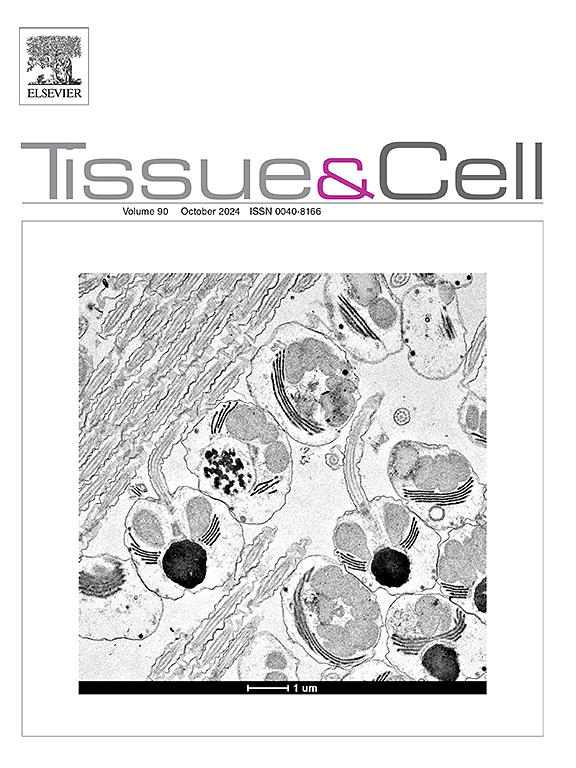Inhibition of the NLR pathway alleviates MAPK1 mutation-driven proliferation and differentiation deficits and enhanced apoptosis in P19 cells
IF 2.7
4区 生物学
Q1 ANATOMY & MORPHOLOGY
引用次数: 0
Abstract
Background
Congenital heart disease (CHD) is the leading cause of birth defect-related mortality. Genetic mutations, including those in the MAPK1 gene, play a critical role in the development of CHD. However, the exact mechanisms by which MAPK1 mutations contribute to CHD remain unclear.
Methods
The MAPK1 mutation (c.1061 T > G, p.F354C) was introduced into P19 murine embryonal carcinoma cells using CRISPR/Cas9 technology. Differentiation was induced with 1 % dimethyl sulfoxide (DMSO), and cell proliferation and apoptosis were assessed using the Cell Counting Kit-8, flow cytometry, and Hoechst staining assays, respectively. Transcriptome sequencing was conducted to explore downstream targets associated with the MAPK1 mutation, and the effects of NOD-like receptor (NLR) pathway inhibition on the phenotype of MAPK1-mutant cells were examined using NOD-IN-1.
Results
MAPK1 mutation notably reduced cell viability, promoted apoptosis, and impaired cardiomyocyte differentiation in P19 cells. Western blot analyses revealed decreased protein levels of Bcl-2 and cilium formation markers (p-GSK3βand DZIP1), alongside elevated levels of Bax in MAPK1-mutant cells. Additionally, the mRNA expression of cardiomyocyte differentiation markers, including cTnT, GATA4, MEF2C, and αMHC, was reduced in P19 cells with the MAPK1 mutation. Cells harboring the MAPK1 mutation exhibited clear chromatin condensation and formed fewer and smaller embryoid bodies. Mechanistically, MAPK1 mutation upregulated the protein expression of NOD1 and NOD2 and increased the phosphorylation of RIP2. Treatment with the NLR pathway inhibitor NOD-IN-1 significantly alleviated the detrimental effects of the MAPK1 mutation.
Conclusion
MAPK1 gene mutation promotes the NLR signaling pathway and affects CHD development, providing new insights into the treatment of CHD.
抑制NLR通路可减轻MAPK1突变驱动的P19细胞增殖和分化缺陷以及增强的凋亡
背景先天性心脏病(CHD)是出生缺陷相关死亡的主要原因。基因突变,包括MAPK1基因的突变,在冠心病的发展中起着关键作用。然而,MAPK1突变导致冠心病的确切机制尚不清楚。方法利用CRISPR/Cas9技术将MAPK1突变(c.1061 T >; G, p.F354C)导入P19小鼠胚胎癌细胞。1 %二甲基亚砜(DMSO)诱导分化,分别用细胞计数试剂盒-8、流式细胞术和Hoechst染色法检测细胞增殖和凋亡。通过转录组测序探索与MAPK1突变相关的下游靶点,并使用NOD-IN-1检测nod样受体(NLR)通路抑制对MAPK1突变细胞表型的影响。结果smapk1突变显著降低P19细胞活力,促进细胞凋亡,损害心肌细胞分化。Western blot分析显示,mapk1突变细胞中Bcl-2和纤毛形成标志物(p- gsk3 β和DZIP1)蛋白水平下降,Bax水平升高。此外,心肌细胞分化标志物,包括cTnT、GATA4、MEF2C和αMHC的mRNA表达在MAPK1突变的P19细胞中降低。携带MAPK1突变的细胞表现出明显的染色质凝聚,形成更少、更小的胚状体。机制上,MAPK1突变上调NOD1和NOD2的蛋白表达,增加RIP2的磷酸化。用NLR通路抑制剂NOD-IN-1治疗可显著减轻MAPK1突变的有害影响。结论mapk1基因突变可促进NLR信号通路,影响冠心病的发展,为冠心病的治疗提供新的思路。
本文章由计算机程序翻译,如有差异,请以英文原文为准。
求助全文
约1分钟内获得全文
求助全文
来源期刊

Tissue & cell
医学-解剖学与形态学
CiteScore
3.90
自引率
0.00%
发文量
234
期刊介绍:
Tissue and Cell is devoted to original research on the organization of cells, subcellular and extracellular components at all levels, including the grouping and interrelations of cells in tissues and organs. The journal encourages submission of ultrastructural studies that provide novel insights into structure, function and physiology of cells and tissues, in health and disease. Bioengineering and stem cells studies focused on the description of morphological and/or histological data are also welcomed.
Studies investigating the effect of compounds and/or substances on structure of cells and tissues are generally outside the scope of this journal. For consideration, studies should contain a clear rationale on the use of (a) given substance(s), have a compelling morphological and structural focus and present novel incremental findings from previous literature.
 求助内容:
求助内容: 应助结果提醒方式:
应助结果提醒方式:


